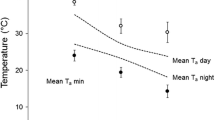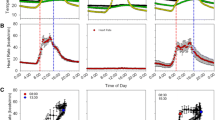Abstract
I aimed to determine when and under which seasonal environmental conditions gray mouse lemurs (Microcebus murinus), a small nocturnal primate species endemic to Madagascar, utilize daily torpor. Using temperature-sensitive radio collars, I measured skin temperature (T sk ) of free-ranging mouse lemurs under natural conditions. My results showed that male and female mouse lemurs in the wild enter torpor spontaneously over a wide range of ambient temperatures (T a ) during the dry season, but not during the rainy season. Mouse lemurs that remained normothermic had significantly lower body masses (mean: 59.7 g) than individuals that used torpor (mean: 80.2 g). Skin temperatures dropped to 20.9°C and the mean torpor bout duration is 10.3 h. The use of torpor on a given night varied among individuals, whereas the propensity for torpor did not differ significantly between males and females. I found no evidence that T a can be used to predict whether mouse lemurs will remain normothermic or enter torpor. It appears that the most reliable indicator for the occurrence of torpor in free-ranging Microcebus murinus is time of the year, i.e., photoperiod.
Similar content being viewed by others
REFERENCES
Atsalis, S. (1999). Seasonal fluctuations in body fat and activity levels in a rain-forest species of mouse lemur, Microcebus rufus. Int. J. Primatol. 20 (6): 883-910.
Audet, D., and Thomas, D. W. (1996). Evaluation of the accuracy of body temperature measurement using external transmitters. Can. J. Zool. 74: 1778-1781.
Aujard, F., Perret, M., and Vannier, G. (1998). Thermoregulatory responses to variations of photoperiod and ambient temperature in the male lesser mouse lemur: A primitive or an advanced adaptive character? J. Comp. Physiol. B 168: 540-548.
Bourliere, F., and Petter-Rousseaux, A. (1966). Existence probable d´un rythme métabolique saisonnier chez les cheirogaleinae (Lemuroidea). Folia Primatol. 4: 249-256.
Brigham, R. M. (1992). Daily torpor in a free-ranging goatsucker, the Common Poorwill (Phalaenoptilus nuttallii). Physiol. Zool. 65: 457-472.
Carpenter, F. L., and Hixon, M. A. (1988). A new function for torpor: Fat conservation in a wild migrant hummingbird. Condor 90: 373-378.
Chevillard, M.-C. (1976). Capacités thermorégulatrices d´un lémurien malgache, Microcebus murinus (Miller, 1777), PhD Thesis, University of Paris.
Corbin, G. D., and Schmid, J. (1995). Insect secretions determine habitat use patterns by a female lesser mouse lemur (Microcebus murinus). Am. J. Primatol. 37: 317-324.
Fietz, J. (1995). Paarungs-und Sozialsystem des Grauen Mausmaki (Microcebus murinus, Cheirogaleidae; J.F. Miller 1777) im laubwerfenden Trockenwald West-Madagaskars, Diploma Thesis, University of Tübingen.
Ganzhorn, J. U., and Sorg, J.-P., eds. (1996). Ecology and economy of a tropical dry forest. Primate Report 46-1, Special Volume, Goltze Verlag, Göttingen.
Geiser, F., and Baudinette, R. V. (1988). Daily torpor and thermoregulation in the small dasyurid marsupial Planigale gilesi and Ningaui yvonnae. Austr. J. Zool. 36: 473-481.
Geiser, F., and Ruf, T. (1995). Hibernation versus daily torpor in mammals and birds: Phyiological variables and classification of torpor patterns. Physiol. Zool. 68: 935-966.
Gursky, S. (1998). Effects of radio transmitter weight on a small nocturnal primate. Amer. J. Primatol. 46: 145-155.
Hladik, C. M. (1980). The dry forest of the west coast of Madagascar: Climate, phenology, and food availability for prosimians. In Charles-Dominique, P., Cooper, H. M., Hladik, C. M., Pages, E., Pariente, G. F., Petter-Rousseaux, A., Petter, J. J., and Schilling, A. (eds.), Nocturnal Malagasy Primates: Ecology, Physiology and Behaviour, Academic Press, New York, pp. 3-40.
Hainsworth, F. R., Collins, B. G., and Wolf, L. L. (1977). The function of torpor in hummingbirds. Physiol. Zool. 50: 215-222.
Heldmaier, G., and Ruf, T. (1992). The impact of daily torpor on energy requirements in the Djungarian hamster, Phodopus sungorus. Physiol. Zool. 65: 994-1010.
Heldmaier, G., and Steinlechner, S. (1981). Seasonal control of energy requirements for thermoregulation in the Djungarian hamster (Phodopus sungorus), living in natural photoperiod. J. comp. Physiol. 142: 429-437.
Hudson, J. W. (1973). Torpidity in mammals. In Whittow, G. C. (ed.), Comparative Physiology of Thermoregulation, Academic Press, London, pp. 97-165.
Hudson, J. W. (1978). Shallow, daily torpor: A thermoregulatory adaptation. In Wang, L. C. H., and Hudson, J. W. (eds.), Strategies in the Cold: Natural Torpidity and Thermogenesis, Academic Press, New York, pp. 67-108.
Kirsch, R., Ouarour, A., and Pevet, P. (1991). Daily torpor in the Djungarian hamster (Phodopus sungorus): Photoperiodic regulation, characteristics and circadian organization. J. Comp. Physiol. A 168: 121-128.
Körtner, G., and Geiser, F. (1995). Effect of photoperiod and ambient temperature on activity patterns and body weight cycles of mountain pygmy-possums, burramys parvus (Marsupialia). J. Zool. 235: 311-322.
Lovegrove, B. G., and Raman, J. (1998). Torpor patterns in the pouched mouse (Saccostomus campestris; Rodentia): A model animal for unpredictable environments. J. Comp. Physiol. B 168: 303-312.
Martin, R. D. (1972). A preliminary field-study of the Lesser Mouse Lemur (Microcebus murinus J. F. Miller 1777). Z. Tierpsychol. 9: 43-90.
Martin, R. D. (1973). A review of the behaviour and ecology of the lesser mouse lemur (Microcebus murinus). In Crook, M. (ed.), Ecology and Behaviour of Primates, Acadmic Press, London, pp. 1-68.
Mittermeier, R. A., Tattersall, I., Konstant, W. R., Meyers, D. M., and Mast, R. B. (1994). Lemurs of Madagascar, Conservation International, Washington DC.
Ortmann, S., Schmid, J., Ganzhorn, J. U., and Heldmaier, G. (1996). Body temperature and torpor in a Malagasy small primate, the mouse lemur. In Geiser, F., Hulbert, A. J., and Nicol, S. C. (eds.), Adaptations to the Cold: The Tenth International Hibernation Symposium, University of New England Press, Armidale, pp. 55-61.
Ortmann, S., Heldmaier, G., Schmid, J., and Ganzhorn, J. U. (1997). Spontaneous daily torpor in Malagasy mouse lemurs. Naturwissenschaften 84: 28-32.
Petter-Rousseaux, A. (1980). Seasonal activity rhythms, reproduction, and body weight variations in five sympatric nocturnal prosimians, in simulated light and climatic conditions. In Charles-Dominique, P., Cooper, H. M., Hladik, A., Hladik, C. M., Pages, E., Pariente, G. F., Petter-Rousseaux, A., Petter, J. J., and Schilling, A. (eds.), Nocturnal Malagasy Primates: Ecoloy Physiology and Behaviour, Academic Press, New York, pp. 137-151.
Perret, M. (1992). Environmental and social determinants of sexual function in the male Lesser Mouse Lemur (Microcebus murinus). Folia Primatol. 59: 1-25.
Perret, M. (1996). Manipulation of sex ratio at birth by urinary cues in a prosimian primate. Behav. Ecol. Sociobiol. 38: 259-266.
Perret, M. (1998). Energetic advantage of nest-sharing in a solitary primate, the lesser mouse lemur (Microcebus murinus). J. Mammal. 79(4): 1093-1102.
Perret, M., Aujard, F., and Vannier, G. (1998). Influence of daylength on metabolic rate and daily water loss in the male prosimian primate Microcebus murinus. Comp. Biochem. Physiol. A 119: 981-989.
Pohl, H. (1967). Circadian rhythms in hibernation and the influence of light. In Fisher, K. C., Dawe, A. R., Lyman, C. P., Schönbaum, E., and South, F. E. (eds.), Mammalian Hibernation III, Oliver and Boyd, Edinburgh, pp. 140-151.
Radespiel, U., Cepok, S., Zietemann, V., and Zimmermann, E. (1998). Sex-specific usage patterns of sleeping sites in Grey Mouse Lemurs (Microcebus murinus) in Northwestern Madagascar. Am. J. Primatol. 46: 77-84.
Ruf, T., Stieglitz, A., Steinlechner, S., Blank, J. L., and Heldmaier, G. (1993). Cold exposure and food restriction facilitate physiological responses to short photoperiod in Djungarian hamsters (Phodopus sungorus). J. Exp. Zool. 276: 104-112.
Russel, R. J. (1975). Body temperature and behavior of captive cheirogaleids. In Tattersall, I., and Sussman, R. W. (eds.), Lemur Biology, Plenum, New York, pp. 193-206.
Sachs, L. (1992). Angewandte Statistik, Springer, Berlin, Heidelberg; New York.
Schmid, J. (1996). Oxygen consumption and torpor in mouse lemurs (Microcebus murinus and Microcebus myoxinus): Preliminary results of a study in western Madagascar. In Geiser, F., Hulbert, A. J., and Nicol, S. C. (eds.), Adaptations to the Cold: The Tenth Hibernation Symposium, University of New England Press, Armidale, pp. 47-54.
Schmid, J. (1997). Torpor beim Grauen Mausmaki (Microcebus murinus) in Madagascar: Energetische Konsequenzen und ökologische Bedeutung, PhD Thesis, University of Tübingen.
Schmid, J. (1998). Tree holes used for resting by Gray Mouse Lemurs (Microcebus murinus) in Madagascar: Insulation capacities and energetic consequences. Int. J. Primatol. 19: 797-809.
Schmid, J. (1999). Sex-specific differences in activity patterns and fattening in the gray mouse lemur (Microcebus murinus) in Madagascar. J. Mammal. 80(3): 749-757.
Schmid, J. (2000a). Daily torpor in the gray mouse lemur (Microcebus murinus) in Madagascar: Energetical consequences and biological significance. Oecologia 123: 175-183.
Schmid, J. (2000b). Torpor in the tropics: The case of the gray mouse lemur (Microcebus murinus). Basic Appl. Ecol. 2: 133-139.
Schmid, J., and Kappeler, P. M. (1998). Fluctuating sexual dimorhism and differential hibernation by sex in a primate, the gray mouse lemur (Microcebus murinus). Behav. Ecol. Sociobiol. 43: 125-132.
Steinlechner, S., Heldmaier, G., Weber, C., and Ruf, T. (1986). Role of photoperiod: Pineal gland interaction in torpor control. In Heller, H. C., Musacchia, X. J., and Wang, L. C. H. (eds.), Living in the Cold: Physiological and Biochemical Adaptations, Elsevier, New York, pp. 301-307.
Sorg, J.-P., and Rohner, U. (1996). Climate and tree phenology of the dry deciduous forest of the Kirindy forest. In Ganzhorn, J. U., and Sorg, J.-P. (eds.), Primate Report, 46-1. Goltze Verlag, Germany, pp. 57-80.
Tattersall, I. (1982). The Primates of Madagascar, Columbia University Press, New York.
Wang, L. C. H. (1989). Ecological, physiological, and biochemical aspects of torpor in mammals and birds. In Wang, L. C. H. (ed.), Advances in Comparative and Environmental Physiology, Springer, Berlin, Heidelberg.
Author information
Authors and Affiliations
Rights and permissions
About this article
Cite this article
Schmid, J. Daily Torpor in Free-Ranging Gray Mouse Lemurs (Microcebus murinus) in Madagascar. International Journal of Primatology 22, 1021–1031 (2001). https://doi.org/10.1023/A:1012069706237
Issue Date:
DOI: https://doi.org/10.1023/A:1012069706237




